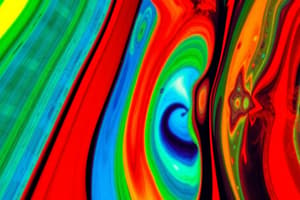Podcast
Questions and Answers
What does JND measure in the context of stimuli?
What does JND measure in the context of stimuli?
- The smallest detectable difference in a stimulus (correct)
- The recognition of a stimulus
- The upper limit of perceived intensity
- The initial response to a stimulus
Which level indicates the point at which the light can first be recognized?
Which level indicates the point at which the light can first be recognized?
- Recognition Level (RL) (correct)
- Terminal Level (TL)
- Difference Level (DL/JND)
- Absolute Threshold
What is the primary difference between sensation and perception?
What is the primary difference between sensation and perception?
- Sensation involves interpretation while perception is just awareness.
- Sensation is the initial sensory detection; perception is the interpretation of that detection. (correct)
- Sensation requires conscious thought; perception does not.
- Sensation happens in the brain; perception occurs in the sensory organs.
What happens beyond the Terminal Level (TL) of stimulus intensity?
What happens beyond the Terminal Level (TL) of stimulus intensity?
In which area is psychophysics primarily NOT applied?
In which area is psychophysics primarily NOT applied?
Which sensory receptors are responsible for responding to mechanical pressure and distortion?
Which sensory receptors are responsible for responding to mechanical pressure and distortion?
How does the intensity of a stimulus affect our perception according to psychophysics?
How does the intensity of a stimulus affect our perception according to psychophysics?
What is the difference between the Absolute Threshold and the Difference Level (JND)?
What is the difference between the Absolute Threshold and the Difference Level (JND)?
What example illustrates the sensation stage?
What example illustrates the sensation stage?
Which statement best defines perception?
Which statement best defines perception?
Which statement correctly describes the Role of TL in perception?
Which statement correctly describes the Role of TL in perception?
What is an example of sensation provided in the content?
What is an example of sensation provided in the content?
What type of sensations does the skin's sensory receptors primarily detect?
What type of sensations does the skin's sensory receptors primarily detect?
Which of the following best describes the practical applications of psychophysics?
Which of the following best describes the practical applications of psychophysics?
What role do mechanoreceptors play in sensory perception?
What role do mechanoreceptors play in sensory perception?
What role do psychophysicists play in relation to stimuli and perceptions?
What role do psychophysicists play in relation to stimuli and perceptions?
What is the primary function of the lens in the eye?
What is the primary function of the lens in the eye?
Which type of photoreceptor is responsible for vision in low light conditions?
Which type of photoreceptor is responsible for vision in low light conditions?
What does the fovea primarily provide?
What does the fovea primarily provide?
What is the function of the choroid layer in the eye?
What is the function of the choroid layer in the eye?
How do the optic nerves transmit visual information to the brain?
How do the optic nerves transmit visual information to the brain?
At the optic chiasm, what happens to the retinal nerve fibers?
At the optic chiasm, what happens to the retinal nerve fibers?
What is the role of the vitreous humor in the eye?
What is the role of the vitreous humor in the eye?
What do cones primarily enable in vision?
What do cones primarily enable in vision?
What is the relationship between frequency and pitch?
What is the relationship between frequency and pitch?
How is amplitude perceived?
How is amplitude perceived?
What does timbre allow us to distinguish?
What does timbre allow us to distinguish?
What is the measurement unit for amplitude?
What is the measurement unit for amplitude?
What does duration refer to in sound?
What does duration refer to in sound?
What is the physical definition of wavelength?
What is the physical definition of wavelength?
What part of the ear is primarily responsible for hearing?
What part of the ear is primarily responsible for hearing?
What is the typical range of frequencies heard by the human ear?
What is the typical range of frequencies heard by the human ear?
What characterizes Fechner's contributions to psychophysics?
What characterizes Fechner's contributions to psychophysics?
What is the difference threshold according to Fechner's concepts?
What is the difference threshold according to Fechner's concepts?
Which method of measurement did Fechner NOT develop?
Which method of measurement did Fechner NOT develop?
How did Fechner’s work impact psychology as a discipline?
How did Fechner’s work impact psychology as a discipline?
In what scenario does adding one candle have a noticeable effect according to Fechner's observations?
In what scenario does adding one candle have a noticeable effect according to Fechner's observations?
What does the absolute threshold refer to?
What does the absolute threshold refer to?
Why do small increases in volume become harder to notice?
Why do small increases in volume become harder to notice?
What does Fechner's Law illustrate about our perception of changes in stimuli?
What does Fechner's Law illustrate about our perception of changes in stimuli?
Flashcards are hidden until you start studying
Study Notes
Psychophysics
- Measures how our perception of stimuli changes as intensity increases, it's not linear, it follows a mathematical pattern.
- Applies to product testing, psychological assessments, and personnel evaluations.
Sensation and Perception
- Two stages involved in experiencing the world
- Sensation - Initial stage of stimulus reaching sensory organs (e.g., hearing a noise, smelling a fragrance, seeing a flash of light).
- Perception - Brain interpreting sensory data and adding meaning (e.g., recognizing the noise as a car honking, identifying the touch as a handshake).
Fechner's Law
- Our perception of changes in stimuli is not linear.
- Senses respond less and less as stimulus becomes more intense.
- Adding one candle to a dark room makes a big difference, adding one to a bright room doesn't change much.
Sensory Thresholds
- Introduced by Fechner.
- Absolute threshold - Minimum intensity of a stimulus that can be detected.
- Difference threshold - Smallest detectable difference between two stimuli.
Methods of Measurement
- Fechner developed methods to measure thresholds:
- Method of limits
- Method of constant stimuli
- Method of adjustment
Foundation of Experimental Psychology
- Fechner's work laid the groundwork for experimental psychology by showing that the mind's response to physical stimuli could be measured quantitatively.
Impact of Fechner
- Established a scientific approach to studying the mind.
Just Noticeable Difference (JND)
- Quantifies the smallest detectable difference in a stimulus.
- Concerned with the perception of changes.
Terminal Level (TL)
- Upper limit of stimulus intensity that can be perceived.
- No further increase in perceived intensity beyond TL.
- Example: Brightness of a light.
Visual Pathway
- Route by which visual information is transmitted to the brain.
- Involves retina, optic nerve, optic chiasm.
Retina
- Thin layer of light-sensitive cells at the back of the eye.
- Converts light into electrical signals.
- Contains photoreceptor cells:
- Rods: low light vision.
- Cones: color and detail in bright light.
Fovea
- Central pit in the macula.
- Provides the clearest vision.
Sclera
- White, tough outer layer of the eye.
- Protects inner components.
Choroid
- Vascular layer between the retina and sclera.
- Provides oxygen and nutrients to the outer layers of the retina.
Aqueous Humor
- Clear fluid between the cornea and lens.
- Maintains intraocular pressure, provides nutrients, and removes waste.
Vitreous Humor
- Clear gel between the lens and retina.
- Maintains eye shape, allows light to pass through.
Sound Waves
- Frequency:
- Corresponds to pitch.
- Higher frequency = higher pitch (whistle).
- Lower frequency = lower pitch (drumbeat).
- Human ear typically hears 20 Hz to 20,000 Hz.
Amplitude
- Height of sound wave, representing energy or intensity.
- Perceived as loudness or volume.
- Greater amplitude = louder sound.
- Measured in decibels (dB).
Timbre
- Characteristic that distinguishes sound sources with the same pitch and loudness.
- Influenced by harmonic content.
- Violin and piano playing the same note sound different because of their unique timbres.
Duration
- Length of time a sound lasts.
- Affects how we perceive rhythm and tempo.
Wavelength
- Distance between two consecutive points of the same phase on a sound wave.
- Inversely related to frequency.
- Higher frequency = shorter wavelength.
- Lower frequency = longer wavelength.
Human Ear
- Organ of hearing and equilibrium.
- Detects and analyzes sound by transduction.
- Maintains the sense of balance.
- Consists of outer, middle, and inner ear.
Outer Ear
- Visible portion (auricle or pinna).
- External auditory canal.
- Tympanic membrane (eardrum).
Receptors in the Skin
- Various types:
- Touch
- Pressure
- Pain
- Temperature
Mechanoreceptors
- Specialized neurons responding to mechanical pressure and distortion.
- Convert mechanical stimuli into electrical impulses that are transmitted to the central nervous system.
Studying That Suits You
Use AI to generate personalized quizzes and flashcards to suit your learning preferences.



